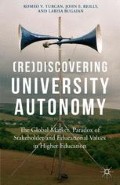Abstract
Staff evaluation is a basic tool of human resources (HR) management, commonly also used in universities (see, e.g., Arreola 2000, Collan, Stoklasa, and Talašová 2014), and is aimed at maintaining the high quality of relevant processes and activities, and at achieving set goals. At universities, staff evaluation may be used, for example, to provide the necessary information for tenure and promotion decisions, remuneration, and other important management decisions involving academic staff. Staff evaluation is a demanding task in any organization, but even more so in the university environment (see, e.g., Meifert 2013). Universities are institutions that are expected to educate people through teaching, to perform high-quality research, and to contribute to the development and well-being of the society as a whole (see Marginson [2007] for a discussion on “university mission” in the context of university rankings/evaluations.) To meet these three broad expectations and, specifically, the goals set for reaching them, universities need to channel their resources in a way that properly addresses each goal and creates incentives for the academic staff to perform in a way that fulfills the set goals. This is where academic staff evaluation systems and the tools of HR management play a strong role. Universities commonly have and historically have had a great deal of autonomy to plan and execute their activities and strategies. The Bologna Process in Europe has changed this picture in terms of degree structures, but when it comes to research, autonomy is often lax. Hand in hand with institutional autonomy comes the “academic freedom” of the individual “researcher” to study the topic of his/her own choosing and to do it in the way of his/her own choosing (for most academic positions, teaching is mandatory).
Access this chapter
Tax calculation will be finalised at checkout
Purchases are for personal use only
Preview
Unable to display preview. Download preview PDF.
References
Anderson, Gina. “Assuring Quality/Resisting Quality Assurance: Academics’ Responses to ‘quality’ in Some Australian Universities.” Quality in Higher Education 12, no. 2 (2006): 161–173.
Arreola, Raoul A. Developing a Comprehensive Faculty Evaluation System: A Guide to Designing, Building, and Operating Large-Scale Faculty Evaluation Systems. San Francisco: Wiley, 2000.
Bana e Costa, Carlos A., and Mónica D. Oliveira. “A Multicriteria Decision Analysis Model for Faculty Evaluation.” Omega, 2012: 424–436.
Burton, Clark. “The Entrepreneurial University: New Foundations for Collegiality, Autonomy, and Achievement.” Higher Education Management and Policy 13, no. 2 (2001): 9–24.
Collan, Mikael, Jan Stoklasa, and Jana Talašová. “Examples of Academic Faculty Evaluation Systems from the Czech Republic and Finland.” Peer Reviewed Full Papers of the 8th International Conference on Evaluation for Practice: “Evaluation as a Tool for Research, Learning and Making Things Better”. University of Tampere, 2012. 111–120.
—. “On Academic Faculty Evaluation Systems: More than Just Simple Benchmarking International.” Journal of Process Management and Benchmarking, no. 4 (2014): 437–455.
Etzkowitz, Henry, and Loet Leydesdorff. “The Dynamics of Innovation: From National Systems and ‘Mode 2’ to a Triple Helix of University-Industry-Government Relations.” Research Policy 29, no. 2 (2000): 109–123.
Gilan, Siamak Safarzadegan, Mohammad H. Sebt, and Vahid Shahhosseini. “Computing with Words for Hierarchical Competency Based Selection of Personnel in Construction Companies.” Applied Soft Computing 12, no. 2 (2012): 860–871.
Gonzalez, Cristina. “Undergraduate Research, Graduate Mentoring, and the University’s Mission.” Science, 2001: 1624–1626.
Holeček, Pavel, Jana Talašova, and Jan Stoklasa. “Fuzzy Classification Systems and Their Applications.” Proceedings of the 29th International Conference on Mathematical Methods in Economics—Part I. Prague: University of Economics, Faculty of Informatics and Statistics, 2011. 266–271.
Marginson, Simon. “University Mission and Identity for a Post Post-Public Era.” Higher Education Research & Development 26, no. 1 (2007): 117–131.
Meifert, Matthias T., ed. Strategic Human Resource Development: A Journey in Eight Stages. Berlin, Heidelberg: Springer-Verlag, 2013.
Rogers, Everett M. Diffusion of Innovations. 5th edition. New York: Free Press, 2003.
Stoklasa, Jan, Jana Talašová, and Pavel Holeček. “Academic Staff Performance Evaluation—Variants of Models.” Acta Polytechnica Hungarica 8, no. 3 (2011): 91–111.
—, Pavel Holeček, and Jana Talašová. “A Holistic Approach to Academic Staff Performance Evaluation—a Way to the Fuzzy Logic Based Evaluation.” Peer Reviewed Full Papers of the 8th International Conference on Evaluation for Practice: “Evaluation as a Tool for Research, Learning and Making Things Better”. University of Tampere, 2012. 121–131.
Yee, C. C., and Y. Y. Chen. “Performance Appraisal System Using Multifactorial Evaluation Model.” In Proceedings of World Academy of Science, Engineering and Technology. 2009. 231–235.
Zemková, Blanka, and Jana Talašová. “Fuzzy Sets in HR Management.” Acta Polytechnica Hungarica 8, no. 3 (2011): 113–124.
Editor information
Copyright information
© 2016 Mikael Collan, Jan Stoklasa and Jana Talasova
About this chapter
Cite this chapter
Collan, M., Stoklasa, J., Talasova, J. (2016). Staff Evaluation Systems—Shaping Autonomy through Stakeholders. In: Turcan, R.V., Reilly, J.E., Bugaian, L. (eds) (Re)Discovering University Autonomy. Palgrave Macmillan, New York. https://doi.org/10.1057/9781137388728_7
Download citation
DOI: https://doi.org/10.1057/9781137388728_7
Publisher Name: Palgrave Macmillan, New York
Print ISBN: 978-1-349-55212-2
Online ISBN: 978-1-137-38872-8
eBook Packages: EducationEducation (R0)

